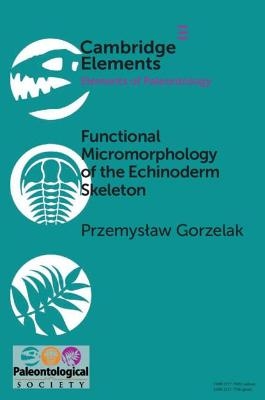
Functional Micromorphology of the Echinoderm Skeleton
Seiten
2021
Cambridge University Press (Verlag)
978-1-108-81031-9 (ISBN)
Cambridge University Press (Verlag)
978-1-108-81031-9 (ISBN)
The study of the stereom microstructure of extinct echinoderms can provide us with important paleobiological and paleoecological information. A wide array of investigating methods are available, and with the variety of types of stereom microarchitecture, each optimized for specific functions, there is great potential for new discoveries.
Echinoderms elaborate a calcite skeleton composed of numerous plates with a distinct microstructure (stereom) that can be modelled into different shapes thanks to the use of a transient amorphous calcium carbonate (ACC) precursor phase and the incorporation of an intraorganic matrix during biomineralization. A variety of different types of stereom microarchitecture have been distinguished, each of them optimized for a specific function. For instance, a regular, galleried stereom typically houses collagenous ligaments, whereas an irregular, fine labyrinthic stereom commonly bears muscles. Epithelial tissues, in turn, are usually associated with coarse and dense stereom microfabrics. Stereom can be preserved in fossil echinoderms and a wide array of investigating methods are available. As many case studies have shown, a great deal of important paleobiological and paleoecological information can be decoded by studying the stereom microstructure of extinct echinoderms.
Echinoderms elaborate a calcite skeleton composed of numerous plates with a distinct microstructure (stereom) that can be modelled into different shapes thanks to the use of a transient amorphous calcium carbonate (ACC) precursor phase and the incorporation of an intraorganic matrix during biomineralization. A variety of different types of stereom microarchitecture have been distinguished, each of them optimized for a specific function. For instance, a regular, galleried stereom typically houses collagenous ligaments, whereas an irregular, fine labyrinthic stereom commonly bears muscles. Epithelial tissues, in turn, are usually associated with coarse and dense stereom microfabrics. Stereom can be preserved in fossil echinoderms and a wide array of investigating methods are available. As many case studies have shown, a great deal of important paleobiological and paleoecological information can be decoded by studying the stereom microstructure of extinct echinoderms.
1. Introduction; 2. Biomineralization, Structure and Biogeochemistry of the Echinoderm Skeleton; 3. Stereom Types and Relationship to Phylogeny, Growth Rate and Investing Soft Tissues; 4. Stereom of Fossil Echinoderms – Preservation Style and Observational Methods; 5. Stereom Microstructure – A Powerful Tool for Assessing the Paleobiology and Paleoecology of Fossil Echinoderms; 6. Conclusions.
| Erscheinungsdatum | 08.02.2021 |
|---|---|
| Reihe/Serie | Elements of Paleontology |
| Zusatzinfo | Worked examples or Exercises |
| Verlagsort | Cambridge |
| Sprache | englisch |
| Maße | 230 x 150 mm |
| Gewicht | 84 g |
| Themenwelt | Naturwissenschaften ► Biologie ► Evolution |
| Naturwissenschaften ► Biologie ► Limnologie / Meeresbiologie | |
| Naturwissenschaften ► Geowissenschaften ► Mineralogie / Paläontologie | |
| ISBN-10 | 1-108-81031-4 / 1108810314 |
| ISBN-13 | 978-1-108-81031-9 / 9781108810319 |
| Zustand | Neuware |
| Haben Sie eine Frage zum Produkt? |
Mehr entdecken
aus dem Bereich
aus dem Bereich
Wie die Vernichtung der Arten unser Überleben bedroht - Der …
Buch | Softcover (2023)
Penguin (Verlag)
15,00 €


